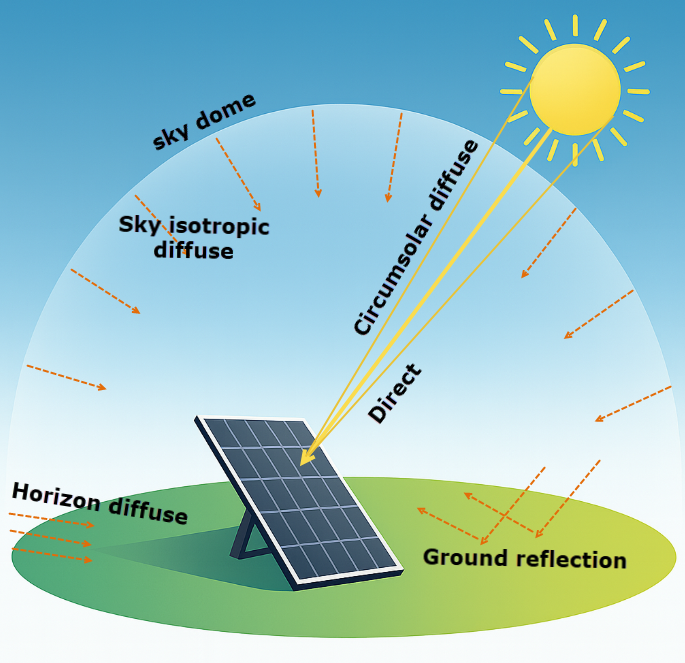Solar radiation components
Solar radiation reaching the Earth's surface is composed of three main components.
- Direct Radiation—Travels in a straight line from the sun and reaches the surface without being scattered or reflected. It is selectively attenuated by the atmosphere.
- Diffuse Radiation—Scattered by molecules and particles in the atmosphere and reaches the surface from all directions.
- Reflected Radiation—Reflected from the ground and nearby surfaces onto the surface.
The total radiation received at the surface—known as global solar radiation—is the sum of these three components.
The ratio of direct to diffuse radiation varies based on the following factors:
- Time of day
- Under clear skies, direct radiation typically accounts for about 85% of total insolation at solar noon. As the sun lowers toward the horizon, the proportion of diffuse radiation increases, reaching up to 40% when the sun is 10° above the horizon.
- Atmospheric conditions
- Cloud cover and pollution increase the scattering of sunlight, raising the proportion of diffuse radiation. On heavily overcast days, nearly all solar radiation is diffuse.
- Latitude and season
- Higher latitudes and winter months tend to have a greater proportion of diffuse radiation due to lower solar angles and increased cloudiness. In contrast, sunnier regions exhibit less seasonal variation in the direct-to-diffuse ratio.
Sky diffuse radiation distribution
Unlike direct solar radiation, diffuse radiation is not evenly distributed across the sky dome. Its spatial distribution is influenced by cloud cover, atmospheric clarity, and solar geometry.

Diffuse radiation can be classified into three directional components:
- Isotropic Diffuse Radiation—uniformly distributed across the entire sky dome and represents the baseline level of scattered light under all sky conditions.
- Circumsolar Diffuse Radiation—caused by forward scattering of sunlight. It is concentrated in the region of the sky surrounding the sun and is most prominent under clear sky conditions.
- Horizon Brightening—concentrated near the horizon and becomes more pronounced in clear atmospheric conditions due to increased scattering at low solar angles.
Understanding the spatial distribution of these components is essential for accurate solar energy modeling, in applications involving tilted or tracking solar collectors. The directional characteristics of diffuse radiation influences how much energy is received depending on surface orientation.
